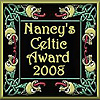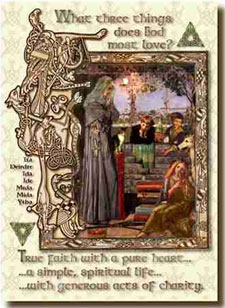| |

Traditions, folklore, history and more. If it's Irish, it's here. Or will be!
"People will not look forward to posterity who never look backward to their ancestors."
-Edmund Burke




Quotes
Library: Books, Movies, Music
Prints & Photos
Poetry
Jokes


Shops Ireland
Bunús na Gaeilge
(Basic Irish)
Circle of Prayer
Blessings
Did You Know?
Himself/Herself
Write to Us
Readers Write..
Links/Link to Us
Advertise with us
Awards & Testimonials
Submissions Guide


|
|
|
St. Ita, foster-mother to the saints of Ireland
by Bridget Haggerty
 After St. Brigid, St. Ita is the most famous woman saint in Ireland. Her birth of noble Christian parents, Kennfoelad, a Déise Chieftain and Necta his princess wife, is said to have taken place around 470 near Faithlegg outside Waterford. After St. Brigid, St. Ita is the most famous woman saint in Ireland. Her birth of noble Christian parents, Kennfoelad, a Déise Chieftain and Necta his princess wife, is said to have taken place around 470 near Faithlegg outside Waterford.
From her baptism on she was filled with the Holy Spirit. All marvelled at her childhood purity and behaviour, and her abstinence on the days she had to fast. She was prudent, very generous, kind toward everyone, and gentle as well as chaste in her language. As she grew up, it quickly became apparent that she wished to devote her life to God.
There is no doubt Ita excelled in the ‘Six Gifts" of Irish womanhood the ancient Celt looked for in the well educated girl - wisdom, purity, beauty, music, sweet speech, embroidery. She refused an offer of marriage as she wanted to consecrate herself completely to Christ. Her father refused her. She went at once to an aged priest she had known from childhood and publicly made her vows which she had already formed in her heart. She left her father’s house and the pleasant places round it and set out with some companions for the Ua Conaill territory in the West of Munster, the present Co. Limerick, to a place called "Cluain Creadhail" which some interpret to mean "Meadow of Faith" and which is now called Kileedy.
Legend has it that Ita was lead to Killeedy by three heavenly lights. The first was at the top of the Galtee mountains, the second on the Mullaghareirk mountains and the third at Cluain Creadhail. Her sister Fiona also went to Killeedy with her and became a member of the community.
Also known as the Brigid of Munster, biographers often compare St. Ita to St. Brigid, but the differences are more striking than the resemblances between these two foremost women saints of the Catholic church. Brigid's life was spent in continual movement. When she had made a success of one convent settlement, she moved off to found another. Ita did just the opposite. Instead of entering one of Brigid's convents, she founded a convent in a district where there was none, at the foot of Sliabh Luachra. The place became known as Killeedy and it was here that she remained until she died.
A strongly individualistic character is glimpsed in the stories that surround her life. When she decided to settle in Killeedy, a chieftain offered her a large grant of land to support the convent. But Ita would accept only four acres, which she cultivated intensively. The convent became known as a training school for little boys, many of whom later became famous churchmen. One of these was St. Brendan, whom Bishop Saint Erc gave to Ita in fosterage when he was a year old. St. Ita kept him until he was six.
The great Navigator revisited her between his voyages and always deferred to her counsel. He once asked her what were the three things which God most detested, and she replied: 'A scowling face, obstinacy in wrong-doing, and too great a confidence in the power of money'. Brendan also asked her what three things God especially loved. She replied, "True faith in God with a pure heart, a simple life with a religious spirit, and open-handedness inspired by charity."
Ita's original name, some claim, was Déirdre, but because of her thirst for holiness she became known as Ita. This quality may have been what drew so many women to join her monastery and families to send their sons to her. Besides her mentoring, Ita is also associated with competence in healing, and an Irish lullaby for the Infant Jesus is attributed to her.
As with other monastic figures of Ireland, she spent much time in solitude, praying and fasting, and the rest of the time in service to those seeking her assistance and advice.
St. Ita died in approximately 570. Her grave, frequently decorated with flowers, is in the ruins of Cill Ide, a Romanesque church at Killeedy where her monastery once stood. A holy well nearby, almost invisible now, was known for centuries for curing smallpox in children and other diseases as well. This well has two names - It is called St. Bernard’s Well on the OS map, but the local name has always been Tobar Bhaile Ui MhÈidÌn, My Little Ita’s Well, coming from the place name, Cill Barra MhÈidÌn. "Church of my little Ita’s Height."
In recent times, the water in the well was said to cure warts and children from the local school, who were suffering from warts, have gone to the well during school hours, to wash the afflicted part and having said the following words: "Bubble up, bubble up, Blessed Well!" three times, have been cured. (Even though tradition has it that the cure only occurs if the well is visited between dusk and dawn!)
There is a strong local following of St. Ita in Munster, particularly in Waterford and Limerick, and her name is a popular one for Irish girls. In the middle of the nineteenth century, a new move was made in Ireland for recognition of her importance in the Catholic church; this was accomplished when Bishop Butler of Limerick obtained from Pope Pius IX a special office and mass for her feast which is now kept on January 15.
Resources:
An extract from the entry on St. Ita in Edward Sellner's "The Wisdom of the Celtic Saints."
1997 Catholic Information Network
"The Saints: A concise Biographical Dictionary", edited by John Coulson, published by Hawthorn Books, Inc. 1960.
Diocese of Waterford and Lismore
Scoil Íde Naofa
Raheenagh, Ballagh, County Limerick
Image: Anachron from PatriArts
|
|
Fri, Sep 27, 2024
 The Galway Hooker The Galway Hooker
This unique vessel, with its distinctive curved lines and bright red sails, originated in the village of Claddagh. During the 19th century, hookers supported a significant fishing industry and also carried goods, livestock and fuel. Seán Rainey is remembered for building the last of the original boats, the Truelight, for Martin Oliver who was to become the last king of the Claddagh; as king, he was entitled to white sails on his boat. Since the mid seventies, many of the old sailing craft which were on the verge of extinction have been lovingly restored and new ones have been built. During the summer months they can be seen at festivals such a Cruinniú na mBád - the Gathering of the Boats - in Kinvara.
Click for More Culture Corner.
Illustrated with designs from the Book of Kells and other Celtic and Irish designs, the prayers reflect a profound view of nature and life. I strongly recommend this to pastors or lay people with any interest in Celtic culture. Edited from an Amazon review
Click here for Celtic Prayers.
|
A fascinating, very cleverly written account that's part fiction and part fact. But don't be misled by the "fiction" part. The stories that Mr. Moorhouse tells are all based on thoroughly researched historical evidence. Bridget Haggerty
"Moorhouse writes with eloquence and a quiet humor calculated to charm even the blackest of heathens." Atlantic Monthly
"The chilling facts of the monks' penitent lives are real enough to send a shiver down an Irish Catholic's spine." New York Times Book Review
Click here for Sun Dancing.
|
|
|
|
|




 The Galway Hooker
The Galway Hooker